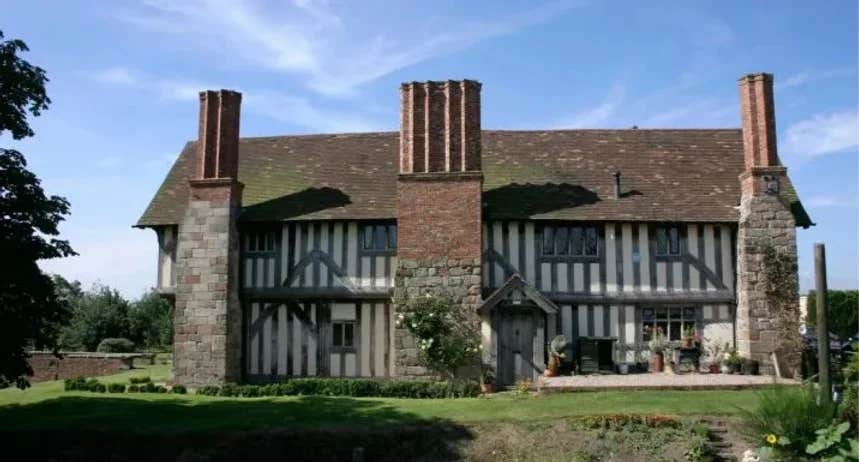Historian believes the Ark of Covenant and Holy Grail are buried under this English house
Treasures of the Knights Templar might lie hidden within a complex network of subterranean passages and chambers beneath this grand estate

The treasures of the Knights Templar might lie hidden within a complex network of subterranean passages and chambers beneath this grand estate. (CREDIT: CC BY-SA 3.0)
In a breathtaking discovery, esteemed historian and anthropologist David Adkins has begun a daring journey that could unveil a fabled trove, rumored to encompass the Ark of the Covenant and the Holy Grail, concealed beneath the venerable Sinai Park House near Burton.
Famed for his earlier unearthing of the 10,000-year-old skull "Greta," David Adkins entertains the conviction that the elusive treasures of the Knights Templar might lie hidden within a complex network of subterranean passages and chambers beneath this grand estate.
Sinai Park House, a majestic landmark in Burton, is believed to rest upon caverns of such vastness that they could potentially rival the size of Westminster Abbey, as asserted by a geologist. This revelation has piqued the interest of both historians and treasure hunters alike, as they contemplate the implications of such a discovery.
David Adkins, who has diligently researched the connections between this Midlands property and the Knights Templar, an elite group of fighters founded in 1119, states, "Sinai House is probably the most important house in England.
It is an awe-inspiring building perched high on a hill overlooking the town. A timber-framed structure, crumbling and at risk, it hides secrets of international importance - and probably conceals the truth behind the Holy Grail itself."
Related Stories:
If David's theory proves to be accurate, it could mark the end of a centuries-old enigma. "There is a strong argument for the famous Templar hoard being buried somewhere under the house," David Adkins asserts. "This theory has never been considered before, and no one has ever carried out geophysical studies under the house."
Historical accounts reveal that attempts were made to explore a concealed passageway at Sinai House during the 1800s, but these efforts were thwarted by fumes, leading to the subsequent bricking up of the cellar's stone archway. The house's historical significance is evident as it once served as a hideout for the Knights Templar, whose founder, Hughes de Payens, had familial ties to the Burton Abbey Estate.
Hughes de Payens, whose name evolved into Pagnel and then Paget in literature, eventually led to William Paget's ownership of the Burton Abbey estate in 1539, which culminated in the demolition of the abbey. David Adkins suggests, "The answer to both questions lies, of course, with the Templar treasure.
Firstly, if Paget was indeed a descendant, he was only around six generations removed from Hughes de Payens. As such, it is highly likely that tales and family myths about the lost treasure being on the Burton Abbey estate had been passed down within his family."
He continues, "Whatever compelled him, it was strong enough for him to firstly acquire the Burton lands then take down the buildings brick by brick. They were looking for something."
David Adkins then delves into a compelling historical connection, saying, "The first major clue which points to the house as the final resting place of the Templar treasure is, in hindsight, blatantly obvious and almost shouts at us from the pages of history. For shortly after the Templars left Jerusalem, the Abbey took personal charge of Sinai House.
The question is why they needed it then; they had never wanted it during the previous 700 years, so why at that particular point in history did they suddenly need the house?"
One remarkable aspect of Sinai House is its unique geographical location atop a labyrinth of natural tunnels and caves. According to Adkins, a geologist informed him that there were caverns beneath the house as large as Westminster Abbey itself. These natural formations would have been an ideal hiding place for the Templars, who were skilled tunnel builders, to conceal their valuable treasures.
Furthermore, Adkins posits that Burton's central location would have appealed to the Knights Templar as a secure spot to protect their treasures from potential invaders. He explains, "Back in 1307, powerful people and foreign governments were understandably keen to acquire the hoard, and any site near the coast would have been considered far too vulnerable. Sinai House in the heart of England did not pose this problem – the Templars knew that an invading force from abroad could never reach the heart of England."
Sinai House's strategic location, flanked by Needwood Forest and the River Trent, added to its obscurity, making it an ideal sanctuary for the Templars. Additionally, the abbots of Burton Abbey were known to be non-conformists, which made them trustworthy allies during the Templar persecution.
Intriguingly, these factors, combined with David Adkins' groundbreaking research, now point to the possibility that the long-lost treasures of the Knights Templar, including the fabled Ark of the Covenant and the Holy Grail, may be awaiting discovery beneath the historic Sinai Park House.
If this theory proves true, it could rewrite history and unveil a treasure trove that has eluded seekers for nearly a millennium. The world watches with bated breath as the investigation into this remarkable historical mystery unfolds.
Note: Materials provided above by The Brighter Side of News. Content may be edited for style and length.
Like these kind of feel good stories? Get The Brighter Side of News' newsletter.



